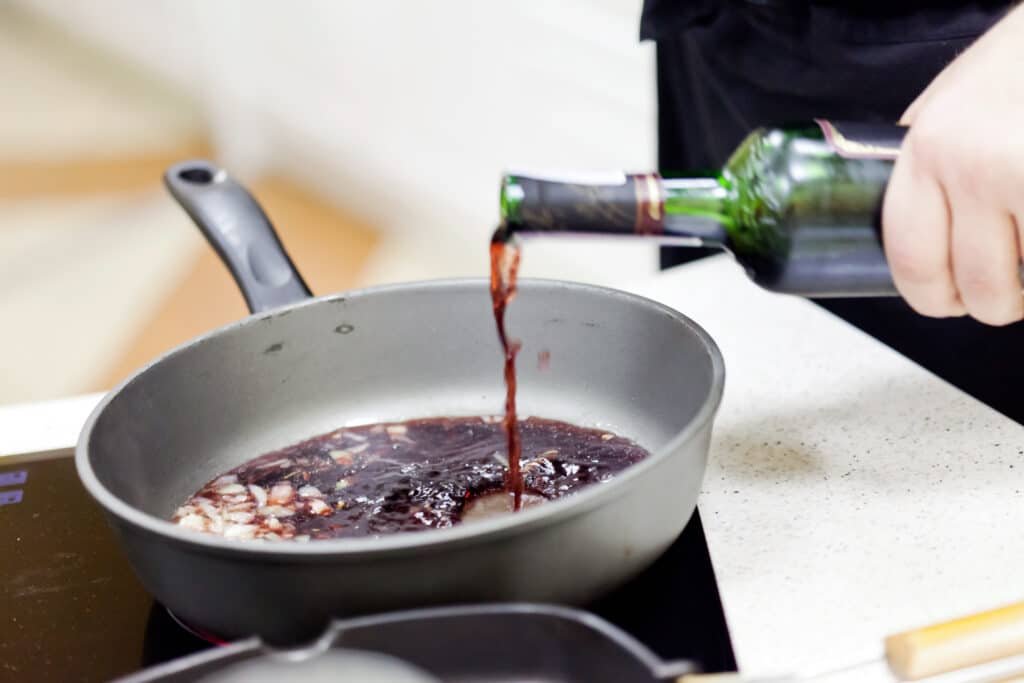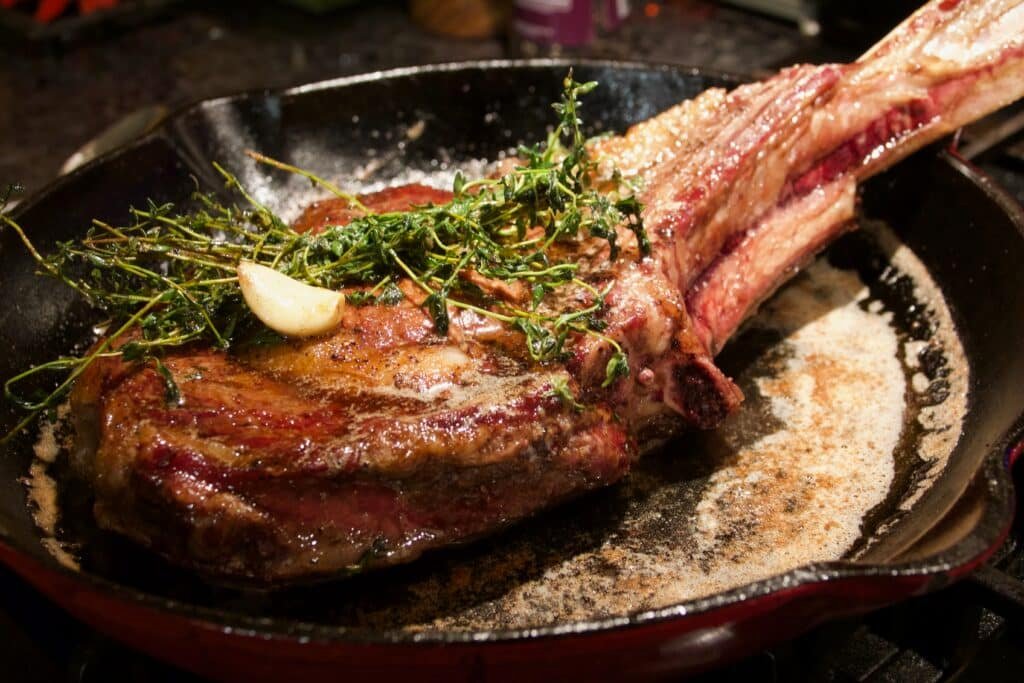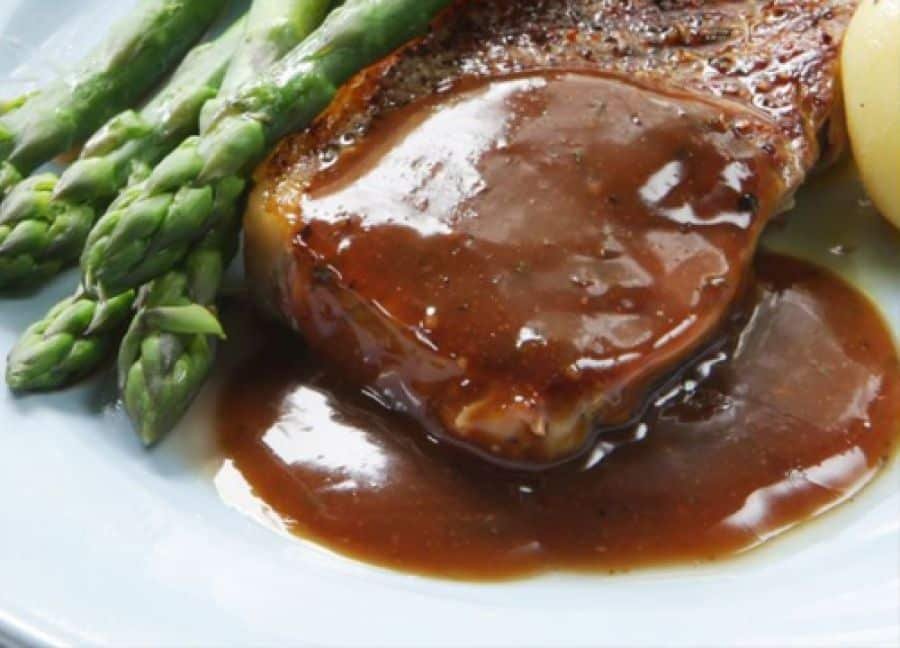
Red wine reduction sauce is a versatile and flavorful addition to many dishes, offering a rich, velvety texture that elevates the taste of meats, vegetables, and more. By gently cooking red wine with aromatics and thickening agents, this sauce can be created within a few simple steps. It has the potential to become a staple in any home cook’s repertoire, as it can be easily customized with various ingredients to suit an array of dishes and trends seen on TikTok or Pinterest.
Creating a red wine reduction sauce begins with choosing quality ingredients. A good red wine, along with fresh herbs, minced garlic, and shallots, will form the base of this delectable sauce. The process of reducing the dry red wine and additional ingredients over heat for about 10 minutes helps concentrate their flavors, resulting in a delicious and complex sauce. With a little patience and attention to detail, a homemade red wine reduction sauce can add an impressive touch to a variety of meals.
When making a red wine reduction sauce, choosing the right ingredients is crucial to create a sauce that complements your dish. In this section, we will explore tips to help you select the right red wine, base ingredient, and other additions to create a delicious red wine reduction sauce.
Picking a good red wine is essential for a balanced and flavorful reduction sauce. Aim for a medium to full-bodied red wine, such as Cabernet Sauvignon, Merlot, or Pinot Noir. Remember that the flavors of the wine will become more concentrated as it reduces, so choose a wine that you enjoy drinking. Avoid using very sweet or dessert wines, as these can result in an overly sweet sauce that is not well suited for most dishes.
The base ingredient is typically the first one that comes into contact with the saucepan and becomes the foundation of your sauce. Common options are olive oil or butter, which are used to sauté the aromatic ingredients like shallots or onions. The choice between olive oil and butter depends on your personal taste and the type of dish you are serving. Olive oil provides a lighter, fruitier flavor, while butter offers a richer, creamier taste.

Incorporating aromatics and flavorings such as shallots and garlic into your red wine reduction sauce can elevate the overall taste and complement the flavors of your dish. This tactic is often celebrated on platforms like TikTok and Pinterest for its ability to enhance flavors. Common additions include:

For this sauce, you’ll need finely chopped shallots or onions and minced garlic. Keep these ingredients organized on the counter or fridge before starting. Shallots can impart a milder flavor compared to onions, so choose based on your preference. Start by peeling and finely chopping one medium-sized shallot or onion. Ensure the pieces are tiny, as large chunks could create an uneven texture in the sauce.
Next, mince one clove of garlic. To do this, first peel the garlic and then chop it into fine pieces for inclusion in your red wine reduction sauce recipe. Alternatively, you can use a garlic press to achieve a consistent result.
Having the ingredients prepared and ready to go will make the cooking process more manageable, allowing you to focus on creating a delicious red wine reduction sauce.
If you’re already familiar with pan-searing meat, you’ll know it leaves behind delicious, caramelized bits stuck to the pan along with drippings from the steak. Whether stainless steel or cast iron, these bits are key to creating a rich, flavorful red wine reduction sauce. After searing your meat and setting it aside to rest, take the same pan and pour in a splash of red wine. Use a wooden spoon to gently scrape the pan, lifting those caramelized bits into the wine.
This process, known as deglazing, infuses the sauce with deep, concentrated flavors, transforming your red wine into a luxurious accompaniment to the tenderloin. If you’re new to pan-searing techniques, consider reading Pan Seared Beef Tenderloin: Juicy & Flavorful to get the best results before you start your sauce.
Begin by adding the liquid of your chosen red wine into a saucepan over medium heat. It’s recommended to use a better-quality red wine for better flavor results in your sauce, such as Pinot Noir, Merlot, or Cabernet Sauvignon. Allow the wine to simmer until its volume has reduced by half. This process can take around 3 to 4 minutes, depending on the amount and type of wine used.
While the wine is simmering, heat olive oil in a separate small saucepan over medium heat, and cook chopped shallots until golden brown, which should take about 5 minutes. After the wine has reduced, Stir in beef broth and a cup of dry red wine for a richer flavor profile in your sauce recipe. to mix with the shallots. Reduce the heat to medium-low and let the mixture simmer until slightly reduced, around 5 minutes.
Next, add aromatics and flavorings to the sauce. Examples of suitable ingredients include minced garlic and fresh rosemary, key to enhancing any basic red wine reduction sauce. Add the finely chopped rosemary to further enrich your red wine reduction sauce recipe. minced garlic and cook until fragrant, which typically takes less than a minute. Then, stir in the wine reduction and let the mixture simmer again on the stove to meld the flavors together.
To achieve the desired consistency and flavor of your red wine reduction sauce, you might need to make some adjustments, such as incorporating a bit of flour to thicken it. If the sauce is too thick, you can add more beef broth; if it’s too thin, continue simmering until the desired consistency is reached. Finally, taste the sauce and season it with salt and pepper according to your preferences, perfecting your red wine reduction sauce recipe. You can also whisk in 1 tablespoon of butter to add a rich texture to your red wine reduction sauce recipe. smooth, creamy texture to your red wine reduction sauce.

A red wine reduction and a demi-glace are both classic culinary sauces that enhance the flavor of dishes, particularly meats, but they differ significantly in preparation and flavor complexity.
Red Wine Reduction: A red wine reduction is made by simmering red wine along with aromatics like garlic, shallots, and herbs until the liquid reduces significantly. This process concentrates the flavors and thickens the sauce, often yielding a slightly syrupy consistency. The reduction can be further enriched with additions like butter or stock. It’s generally quicker to prepare and focuses on highlighting the wine’s flavor, often used to deglaze pan residues after searing meat, capturing those rich, caramelized flavors.

Demi-Glace: Demi-glace, on the other hand, is a much richer and more complex sauce. It starts with a stock, typically made from veal or beef bones, which is simmered for many hours on the stove to extract flavor and reduce volume. This stock is then combined with a brown sauce or espagnole sauce (a basic sauce made from roux instead, veal stock, tomato, and mirepoix) and further reduced until it achieves a thick, glossy consistency. The result is a deeply flavorful sauce that can be used on its own or as a base for other sauces. Making demi-glace is a time-intensive process, but its rich, deep flavor is highly prized in fine dining.
In essence, while both sauces aim to enhance dishes with a concentrated flavor, a red wine reduction is simpler and quicker to prepare with a clear wine-driven taste, whereas demi-glace involves a lengthier process with a profound complexity of flavors derived from its stock and roux base.
A red wine reduction sauce brings out the best flavors in many dishes. It is particularly suitable with meats like beef and lamb. For instance, a classic culinary pairing involves drizzling this sauce over a tender cut of beef tenderloin, filet, or pork chops., or pork chops. beef tenderloin, filet or a juicy rack of lamb. The rich, robust flavor profile of the sauce also complements poultry dishes, such as roast duck or turkey.
In addition to meat dishes, this versatile sauce can enhance vegetarian options as well. It pairs well with robust vegetables like mushrooms, artichokes, and even pasta dishes, adding depth and complexity to their taste.

The serving temperature of a red wine reduction sauce is essential to bring out its full potential. The ideal temperature for this sauce is warm or slightly above room temperature. When heated correctly, the sauce’s consistency becomes syrupy, highlighting its rich flavors and making it an excellent accompaniment to various dishes, perfect for any red wine reduction sauce recipe.
To achieve the desired temperature, you can gently reheat the sauce in a saucepan over low heat, stirring occasionally to prevent scorching. Alternatively, you can heat it in a microwave-safe container at short intervals, stirring between each round to ensure even heating. Remember not to overheat the sauce, as this might affect its consistency and taste.
A red wine reduction is a wonderful pan sauce that can add depth and richness to dishes, especially when drizzled over roasted meats or steaks, braised short ribs, or used in hearty stews. Here’s a straightforward recipe for a red wine reduction:
This enhanced version of red wine reduction with beef stock and a cup of dry red wine is a great way to add a gourmet touch to your meals, making them feel more luxurious and flavor-packed. Enjoy this basic red wine reduction sauce with your favorite dishes!